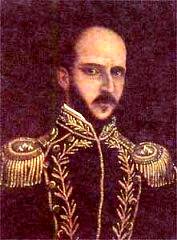Tomás de Herrera
| Tomás de Herrera | |
|---|---|
 |
|
| President of the Free State of the Isthmus* | |
|
In office November 18, 1840 – December 31, 1841 |
|
| 12th President of the Republic of the New Granada | |
|
In office April 21, 1854 – August 5, 1854 |
|
| Preceded by | José María Melo |
| Succeeded by | José de Obaldía |
| Personal details | |
| Born |
Tomás José Ramón del Carmen de Herrera y Pérez Dávila December 21, 1804 Panama City |
| Died | December 1, 1854 (aged 49) Bogotá, Cundinamarca |
| Political party | Liberal |
| Spouse(s) | Ramona de Urriola Obarrio |
| Religion | Roman Catholic |
|
|
Tomás José Ramón del Carmen de Herrera y Pérez Dávila (21 December 1804 – 5 December 1854) was a neogranadine statesman and general who in 1840 became the first Head of State of the Free State of the Isthmus, now Panama. Tomás de Herrera also became President of the Republic of the New Granada in 1854 during the rebellion against the incumbent president José María Melo.
Herrera was born on December 21, 1804. He entered military service in 1822 and became a lieutenant. He participated in the battles of Junín and Ayacucho against the royalists in Peru. In 1828 he was charged with conspiracy, and jailed in Bogota. Herrera escaped, was recaptured and sentenced to death, but his sentence was commuted to banishment. Upon completion of sentence, he returned to Panama in 1830 and participated in the fight against Colonel Alzuru. When Alzuru was shot, Herrera was appointed Colonel Commandant General of the Isthmus of Panama. He fought in the Cauca revolution in 1840 but the isthmus population did not want to join that conflict. A popular meeting in Panama on Nov. 18, 1840 voted for the separation of Panama from Colombia, under the name of the State of the Isthmus with Colonel Herrera as president. He then organized the economy and obtained that Costa Rica and the United States would recognize the new country. The State of the isthmus lasted only 13 months. An agreement to which Herrera opposed reconvened the union between Panama and Colombia, which lasted until 1903.
In 1845, Herrera returned to national political life as governor of Panama and later minister of War and Navy of the government of José Hilario López. In 1850, he was appointed governor of the province of Cartagena and that same year he received the grade of general. In 1851 a revolution erupted in the provinces against the conservative government of President José Hilario López, whereupon the government appointed military commanders to quell the insurgency. Herrera had to confront the governor of Antioquia, Col. Eusebio Borrero, who was defeated and considered General Herrera as a military genius.
Herrera was appointed by the presidency of Colombia in 1854 when he was a member of Congress. President José María Obando was ousted by a military coup on April 17 of that year. Vice President José de Obaldía met with Herrera and other characters in the Legation of the United States to try to assume power, offering Herrera the secretariat of war, nomination that the general refused because it deprived him of his congress seat. Days later, Herrera managed to evade military custody that the dictator Melo had established in Bogota. On April 21, he arrived to Chocontá, where he declared himself exercising the executive power as a result of a letter of Obaldía stating that he was not able to form a government.
...
Wikipedia
